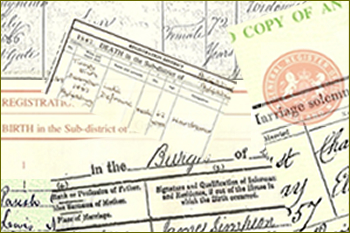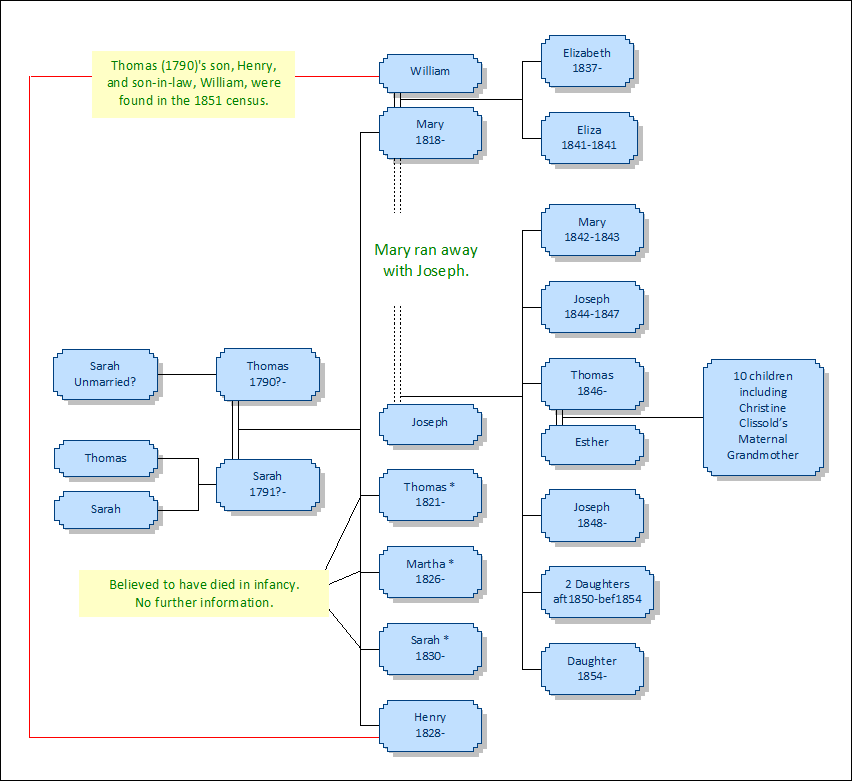I started doing family tree research in the late 1970s, although I had always been interested in hearing the family stories since I was a small child. Once I got researching, I found that Mum’s maternal ancestors were something of a mystery wrapped in a shroud of secrecy, beneath a veil of fog.
In the beginning, I spent hours at the General Record Office (GRO) at St Catherine’s House in London trawling the heavy ledgers, searching for Mum’s aunts’ and uncles’ birth registrations, with no success. Mum herself was the youngest of Gran’s children, and it was two of her sisters who provided the bulk of my initial information. I was told their grandparents had had seven children including Gran. One of my aunts told me that before 1900 it wasn’t compulsory to register births, marriages and deaths (much she knew, bless her heart). As my research continued and I gained more knowledge, I learned that registration had been compulsory from 1871 onwards, with financial penalty for non-compliance, therefore my great grandparents, Thomas and Esther, could have been fined – had they been caught.
I had to return to paid work in 1990, which meant I couldn’t do much research. However after I retired in 2000 I took up genealogy when I received a letter from the wife of a distant cousin (Irene), who had tracked me down. I knew about this distant cousin, but not where he was. I joined forces with Irene, and later another distant cousin on that line of descent, Derek, and his wife. I found Irene to be a brilliantly experienced researcher. She literally knocked my earlier research experiences into a cocked hat, and I have told her she’s the ‘font of all research knowledge’. I learned a great deal from her – where to look for information on the internet and how to evaluate the findings, and most importantly, check, double check, and check again.

By this time we all had home computers, and there was more information on the internet than I’d ever had access to during the 1980s, and we found Gran’s family in census returns. I started buying BMD certificates and we slowly (and expensively) collated the history of these people.
Irene had access to the censuses, and we learned that the correct order of births meant Gran was not the youngest. We also discovered a brother, William, younger than Gran, who she hadn’t apparently mentioned to her offspring. When the 1911 census was released, Irene bought credits to get the image and we learned that Gran’s parents had a total of ten children, three of whom were deceased. We had by this time accounted for eight births. Only children 1, 2, and 4 were registered, and we only picked up on William because he was on the 1891 census and I was able to find his death entry. Another child, Harry, also died young (no GRO birth entry), but I found his death entry and bought the certificate, which indicated his birth ‘window’. So, who were the two missing children? I checked deaths, and played a hunch to find a Florence who ‘filled’ a gap in the known order of births, so I ordered that certificate and thus confirmed that she was Gran’s younger sister. The hunch was based on the fact that Gran and her sisters all had daughters they’d called Florence. This left one child unaccounted for. Irene found a baptism entry for a boy born in 1871, to parents of the same name as our great grandparents. There was no GRO birth registration for this child, nor a death registration. Our great grandparents married in 1874, but I am convinced that this is the tenth child.
Thomas and Esther moved around an awful lot, and we have theories on why – but I wont go into detail because I’ve no proof. When Thomas married, he said his father Joseph had been a cordwainer. Other documentation we have shows that Joseph had been a chimney sweep, labourer and bricklayer. To be a cordwainer would have meant an apprenticeship and we know the family were dirt poor so there was no way Joseph could have afforded one. I concluded that this was a case of posthumous promotion, as Thomas would have wished to impress his bride’s family.
Thomas’s bride, Esther, came from a family who were a bit of an enigma as well. Esther’s father seems to have firmly believed in disinformation and not all his children were registered. There was a lot of conflicting information given in census returns and on certificates. However there were enough clues for us to confirm that we were on the right trail and it was the correct family – but that’s another story.
So, we’d worked back to Thomas and his parents, Joseph and Mary. They too didn’t seem to believe in GRO registration very much, but thanks to the International Genealogy Index (IGI) baptism entries that we found and some certificates, we pieced together the fact that Joseph and Mary had a child born in 1844 named Joseph Thomas. The next child was Thomas – born while Joseph Thomas was still alive. Then after that there was a child named Joseph, but by this time little Joseph Thomas had died. Then there were two daughters, both of whom died in infancy. Then in 1854 there was another daughter who survived and lived to a ripe old age – I have a photograph of her as an old lady that was kindly sent to me by her great grandson who I found as a result of researching Thomas’ sister (born 1854) and her descendants.
Back to Joseph and Mary – Irene found Joseph on the 1841 census living in a lodging house of chimney sweeps. The head of the household was called Thomas and he was a chimney sweep. We wondered if this man was Mary’s father, as Mary and Joseph had certainly liked the name Thomas! I turned the GRO Index inside out and upside down, searching for a marriage entry for Joseph and Mary between 1841 and 1844, but found nothing.
In the meantime, Derek had found death details for a child called Mary whose parents were Joseph and Mary, and later on Irene found baptism details for this same child. She was born at the end of 1842 and died in early 1843, and we are sure this is the oldest child of Joseph and Mary.
The one thing about genealogy research is that for every question which is answered, another ten questions spring up. In the 1851 census, Thomas was not with his parents and we couldn’t find him anywhere else. Two weeks ago I ran another search for Thomas, allowing for name variants (which we hadn’t done previously) and I found him (mistranscribed but we know it’s the correct child because of where he was born) visiting with a man who we know was the son of ‘Thomas The Sweep’ – ergo this man was Mary’s brother, so our great grandfather, Thomas, visiting his uncle. This conclusively connected Mary to Thomas The Sweep.
I then looked for Thomas The Sweep in the 1851 census, and found him still sweeping. Living with him was William his son-in-law, also a chimney sweep. So, I thought, who the heck was William married to, because I thought I’d accounted for all the daughters of this Thomas, and I was still assuming Joseph and Mary had married between 1841 and 1844. I searched the IGI, to find that William had married Mary in 1837, and they’d had two daughters, one being born in 1841 but she died shortly after. I found William and Mary in the 1841 census, with their oldest daughter, living practically next door to Thomas The Sweep.
I’ve done cross-reference checks, and come back to the same findings and conclusions. Irene has checked my findings, and agrees with me. Mary left her husband William sometime between 1841 and 1842, following the death of the 1841 baby, to run away with Joseph (who had been lodging with Mary’s father) – and this is why I never found a marriage entry for them.
It seems to have been commonplace for girls to be pregnant at the altar, and a family history librarian told me that the promise to marry was as legally binding as the ceremony itself, therefore many young couples pre-empted their wedding night, and the respective parents turned a blind eye as long as the young couple married. A man could be sued for breach of promise if he didn’t turn up at church on the wedding day. I think it only became a scandal if the young man refused to marry the girl, such as if she was a serving girl ‘taken down by the young master of the house’ – the ‘stuff’ of Catherine Cookson novels.
My sister gained a BA studying various aspects of 19thC life and she said that by the end of the 19thC the morality and temperance movements were kicking in, leading to the stricter morality we grew up with in the 20thC, that girls should be chaste at the altar, not chased to the altar. I realised that when the ‘Swinging Sixties’ came, all that really happened was that people returned to the morals of past centuries.
However, in 1841/42 it would have been considered scandalous for a married woman to run away with another man and leave not just her husband but a child as well, as William and Mary’s first child was still alive in 1851. The way things were at that time – before the Married Woman’s Property Act – poor working class women didn’t normally leave their husbands. Divorce, for the working classes, wasn’t always an option. They’d have had no money of their own, so they stayed and ‘roughed it out’ even if their husband drank and beat them. I’ll never know what really happened but the most likely explanation is that when Mary’s child died she had a breakdown and couldn’t turn to her husband William for comfort. For all I know, William could have been indirectly accidentally responsible for the child’s death, so Mary turned to Joseph instead.

William died in the 1880s and Mary died in the 1890s, but Joseph went off the radar after 1854. In the 1861 census Mary said she was a widow (which of course she wasn’t, given that she was still married to William), but given what I know now, I am considering the possibility that Joseph didn’t die but abandoned her. I never found a relevant GRO death entry for him, and someone kindly did me a favour and checked the National Burial Index (NBI) and there was no relevant death entry between 1851 and 1861 for Joseph there either.
I feel that Thomas must have known about his mother’s history, because he’d had contact with his maternal uncle in the village where his mother had been born and where his grandparents still lived in 1851 – and William too, of course. Mary worked as a needlewoman in her old age, and I wonder if she ever considered returning to William after 1861 because she must have been very lonely living in London, always in rented rooms, especially once her two surviving children had left home. My research indicates that Mary’s parents died between 1851 and 1861 so there was no one to take her in. It’s a sad little tale, made sadder by the fact that the social constraints of the day meant great grandfather Thomas would always have had to live a ‘cover story’.
Christine Clissold
© Christine Clissold 2010
Useful online resources